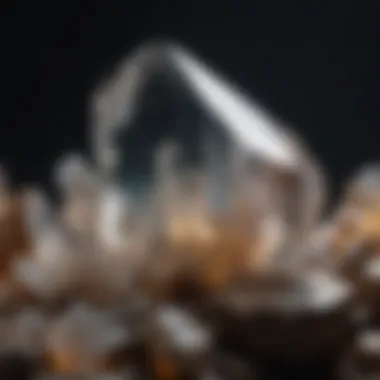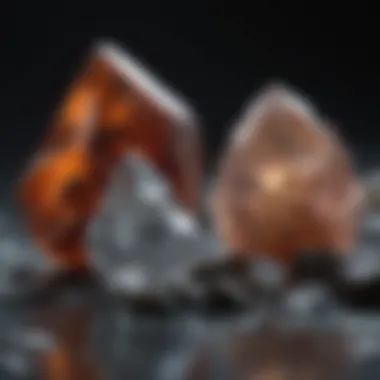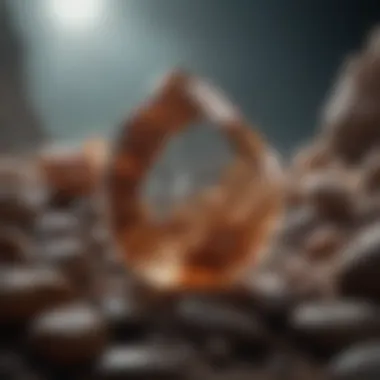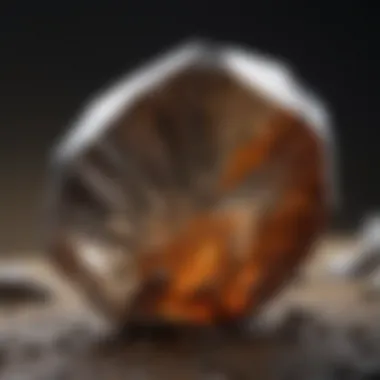How to Determine Your Crystal's Authenticity


Intro
Understanding the authenticity of crystals is crucial for collectors and enthusiasts alike. The market for crystals has expanded significantly, making it essential to discern the real from the counterfeit. This guide offers insights that refine your skills in spotting genuine specimens. We will explore visual traits, the importance of sourcing, and common mistakes that can lead to misidentification. It is imperative to approach this topic thoughtfully, as accurate information fosters a more rewarding collecting experience.
Featured Collectible of the Month
- Overview
This month's featured collectible is the Amethyst, a popular and highly sought-after crystal. Known for its striking purple hue, Amethyst has captivated collectors for centuries. Its beauty and purported healing properties make it a staple in many collections. - Historical Significance
Historically, Amethyst was favored by royalty and used in crowns and jewelry. Its significance goes beyond mere aesthetics; it has been valued in various cultures for its believed protective properties. Understanding this context can enhance your appreciation and discernment when evaluating this crystal.
Identification Techniques
Visual Characteristics
Determining the authenticity of crystals begins with visual inspection. Authentic Amethyst, for instance, showcases a rich, vibrant purple color. Look for variations in shades, as natural stones often exhibit color zoning. Additionally, evaluate its translucency. Genuine crystals allow light to pass through, revealing innate qualities.
- Key Traits to Observe
- Color: Natural hues may include multiple shades.
- Clarity: Impurities can indicate authenticity.
- Surface: Examine for scratches or polish marks.
Resources for Identification
Using reliable resources is paramount in your quest to identify authentic crystals. Websites such as Wikipedia and Britannica can provide essential knowledge about certain crystals and their properties. Community forums on Reddit and Facebook also offer shared experiences from fellow collectors, which can be incredibly valuable.
"Understanding the historical and visual characteristics of crystals is key to authenticity. Knowledge is power in collecting."
By leveraging these resources, you can enhance your understanding and make confident decisions.
Identifying authentic crystals is an art that benefits from patience and careful observation. Being informed is your strongest asset in navigating the complex world of crystal collecting.
Prelude to Crystal Authenticity
The topic of crystal authenticity is significant for both collectors and enthusiasts. Understanding how to determine the authenticity of crystals nurtures a deeper appreciation for these geological treasures. The nuances of crystal characteristics, sourcing methods, and common pitfalls shape a collector's journey. Knowing the genuine from the fake can enhance not only the value of one's collection but also the satisfaction derived from the hobby.
Understanding the Importance of Authenticity
Authenticity in crystals goes beyond mere appearance. It is crucial for several reasons. First, authentic crystals hold intrinsic value, both economically and energetically. Collectors aim for genuine specimens, as they reflect true geological processes. Misidentified or synthetic stones suffer from a lack of authenticity. This can lead to disappointment and financial loss.
Moreover, knowing the real from the false aids in forming an emotional connection with the crystals. Each piece has a unique story, which adds to its charm. Collectors often seek out rare or unusual specimens that resonate with their personal experiences. Without the assurance of authenticity, these meaningful connections dissolve.
Furthermore, understanding authenticity promotes responsible collecting practices. It encourages enthusiasts to source their crystals from reputable vendors. When collectors value authenticity, the entire community benefits from higher standards and ethical guidelines in sourcing and selling crystals.
The Growing Trend of Crystal Collecting
In recent years, the trend of crystal collecting has surged significantly. Both online and offline, communities dedicated to this pursuit have expanded. Social media platforms like Facebook and Reddit provide spaces for sharing knowledge and personal collections. This increased visibility fosters greater interest and curiosity about crystals.
More people are turning to crystals for various reasons. Some are attracted to metaphysical properties, while others appreciate their beauty and geological significance. As interest grows, so does the risk of encountering fake or misrepresented items. Collectors must navigate this landscape carefully.
The influx of new collectors underscores the importance of understanding crystal authenticity. With a higher demand for crystals, it becomes essential to differentiate genuine specimens from counterfeits. The potential for misidentification leads to a frequent need for education on what constitutes an authentic crystal.
In summary, the journey of discovering crystal authenticity enriches the experience of collecting. Both seasoned and novice collectors must approach this topic with curiosity and diligence. By understanding the importance of authenticity and recognizing the growing trend in crystal collecting, collectors can empower themselves and enhance their collections.
Physical Characteristics to Examine
Understanding the physical traits of a crystal is essential for any collector or enthusiast. Physical characteristics can reveal a great deal about the authenticity of a specimen. By examining aspects such as color, transparency, inclusions, and density, one can discern whether a crystal is genuine or a mere imitation. Each feature contributes to the overall identity of the crystal, and neglecting to assess these traits can lead to significant missteps in a collection. Therefore, familiarity with these elements serves as both a safeguard and a means to enhance collector knowledge.


Color and Transparency
The color of a crystal plays a critical role in its identification. Authentic crystals often present a unique color range typical to their mineral species. However, the same can be said for synthetic crystals, which can be manufactured in vibrant colors that do not occur naturally. Transparency is another aspect worth noting. Genuine crystals can vary from transparent to opaque, and sometimes, the clarity of a crystal can provide clues to its origin. For example, an authentic aquamarine should appear clear and bright, whereas a poorly made imitation may appear murky.
When inspecting color and transparency, collectors might consider using a light source to view the effects of light passing through the crystal. This can help reveal any imperfections and assist in determining authenticity. Further, many authentic crystals will exhibit a subtle spectrum of hues due to their internal structure, often referred to as pleochroism.
Inclusions and Flaws
Inclusions are internal features found within a crystal that can aid in its identification. Natural crystals often contain inclusions, which can include air bubbles, minerals, or other imperfections. These can tell a story about the crystal’s formation and origin. By contrast, synthetic crystals tend to be more uniform, lacking these natural variances. Evaluating inclusions requires careful examination, often with a jeweler's loupe or magnifying glass.
Common inclusions to look for include:
- Feathers: Thin, fibrous inclusions that indicate natural growth.
- Needles: Long, slender inclusions that may point to specific types of crystal structures.
- Clouds: Areas within a crystal that appear hazy can indicate natural origins.
Identifying these flaws can help prevent acquiring synthetic crystals. As a rule, if a crystal appears too perfect, it may warrant further investigation.
Weight and Density
Weight and density are often overlooked factors in determining authenticity. The density of a crystal can indicate whether it is genuine. Each mineral has a specific density that can be tested using basic scales. For instance, a genuine quartz crystal should weigh considerably more than most imitations.
To measure density, a simple method is the water displacement technique. This involves weighing the crystal, then submerging it in water to measure the volume displaced. Density is calculated by dividing mass by volume. If a crystal's weight significantly deviates from the expected density of its type, that could suggest a counterfeit.
"Understanding the physical characteristics of crystals is not just about discerning authenticity; it’s a way to connect deeply with the natural world they represent."
Identification Techniques
Understanding how to identify authentic crystals is essential for collectors and enthusiasts. Using proper techniques not only aids in confirming the authenticity of your specimens but also enhances your overall collecting experience. Collectors can develop a keen eye for detail by employing various identification methods, which leads to informed purchasing decisions and reduces the risk of acquiring counterfeit items. The following sections will delve into several effective identification techniques.
Visual Inspection Methods
Visual inspection is among the first steps to ascertain a crystal's authenticity. This method involves closely examining physical features such as color, clarity, and overall structure. Here are some elements to consider during a visual inspection:
- Color: Authentic crystals usually have consistent color patterns. Variability may indicate synthetic materials.
- Transparency: Crystals should ideally be transparent or translucent. Opaque crystals may raise a flag, depending on the specific type of crystal in question.
- Surface Quality: Look for any scratches or abrasions on the surface. Authentic specimens generally exhibit minimal flaws.
- Inclusions: Natural crystals often have unique inclusions, which enhance their value and tell their geological story. Examining these within your crystal can provide significant clues about authenticity.
A thorough visual inspection can often reveal inconsistencies that suggest a crystal is not genuine.
Utilizing UV Light
Ultraviolet (UV) light offers another critical tool for identifying genuine crystals. By illuminating a specimen with UV light, collectors can observe reactions that could indicate authenticity. Different crystals exhibit varied reactions under UV light. Here are some key points to note:
- Fluorescence: Some authentic crystals will fluoresce, while synthetic counterparts often do not. For instance, certain variations of fluorite glow under UV exposure.
- Color Changes: Authentic crystals may change color when exposed to UV light, signaling their natural composition. Synthetic crystals often remain unchanged.
- Detection of Impurities: Subtle impurities in authentic crystals can become visible under UV light, providing further evidence of their originality.
Scratch Tests for Hardness
Conducting scratch tests for hardness offers definitive insights into the authenticity of a crystal. Each type of crystal has a specific hardness rating on the Mohs scale. By testing your specimen against known materials, you can gauge its hardness. For effective scratch testing:
- Prepare Testing Materials: Use objects of known hardness, such as a fingernail or a piece of glass, to compare against your crystal.
- Assess the Scratch Resistance: If your crystal scratches easily against a harder material, its authenticity must be questioned.
- Understand the Limits: Remember that this test is not universally applicable. Some crystals may scratch each other depending on their specific attributes.
The Role of Temperature and Conductivity
Understanding the role of temperature and conductivity is essential for anyone seeking to determine the authenticity of crystals. These physical properties can provide significant clues about a specimen's identity. When assessing crystals, both temperature and conductivity should be leveraged to differentiate between genuine stones and synthetic imitations. Applying reliable methods can enhance the collector's ability to spot discrepancies that often escape the untrained eye.
Thermal properties reflect how a material responds to heat, which can vary based on its composition and structure. Conductivity, on the other hand, indicates how well a material can transmit electric current. For crystal enthusiasts, knowing how to evaluate these properties can greatly improve authenticity assessments.


Thermal Conductivity Tests
Thermal conductivity tests are a practical approach to determine the authenticity of crystals. Various types of minerals exhibit distinct thermal conductivities. By comparing the heat response of a crystal against benchmarks, collectors can discern if a crystal is genuine.
Method
- Obtain a thermal conductivity meter: Devices like the Laser Thermal Conductivity Analyzer are typically used.
- Calibrate your device: Confirm it is appropriate for mineral testing.
- Take readings: Place the probe on the crystal and record the temperature changes.
Different crystals will show diverse readings. For example, diamonds possess a high thermal conductivity compared to most quartz varieties. Any significant deviation from expected values may indicate a synthetic alternative or misidentified specimen.
"It is important to note that some synthetic crystals can replicate the thermal properties of natural ones, so cross-referencing results is advisable."
Heat Sensitivity Observations
Another vital aspect of determining authenticity involves observing how crystals react to heat. Many natural crystals respond differently than synthetics when exposed to temperature changes.
Natural stones often display a gradual temperature adjustment, absorbing heat and dissipating it. Conversely, certain synthetic crystals might show quick responses or melting points that do not align with natural counterparts.
Observation Techniques
- Direct flame exposure: Carefully expose the crystal to a flame for a short time. Genuine minerals may change color or texture gradually, while synthetics may not respond as expected.
- Heat source application: Use a heat gun to observe surface reactions. Look for signs of melting or overheating, which should not occur in pure minerals.
By integrating thermal conductivity tests and heat sensitivity observations, collectors can build a comprehensive understanding of their crystals. These methods, when used together, enhance the ability to uncover the truth and add confidence to the collection process.
Sourcing and Provenance
Sourcing and provenance play a crucial role in determining the authenticity of crystals. The origin of a crystal influences its value, quality, and overall integrity. When collectors understand where their crystals come from, they can make more informed decisions. This knowledge helps differentiate between genuine specimens and those that may be synthetically created or misrepresented. Moreover, tracing a crystal's journey allows for a greater appreciation of its history and the craftsmanship involved in its preparation.
Reputable Sources and Vendors
Identifying reputable sources and vendors is fundamental for collectors. Reliable vendors not only sell authentic crystals but also provide documentation that supports the claims they make. It is advisable to seek out vendors who have established a positive reputation in the crystal community. Here are some tips for choosing reliable sources:
- Research the Vendor: Look for reviews or testimonials from previous customers.
- Ask for Certifications: Ensure that the vendor provides adequate proof of authenticity, like certifications.
- Check Refund Policies: A trustworthy vendor often provides a clear return policy, indicating confidence in their products.
Purchasing from well-known shops or online marketplaces with a strong following can enhance your buying experience. Engaging with communities on platforms like reddit.com or facebook.com can also lead you to reputable sellers.
Understanding the Supply Chain
The supply chain of crystals involves various stages from extraction to eventual sale. Knowing how crystals are sourced can illuminate potential authenticity issues. The journey usually includes mining, cutting, and distribution. Here, a few aspects should be considered:
- Mining Location: Authentic crystals often come from regulated mines. Knowing the origin can help you understand its authenticity better.
- Middlemen: Be aware of any middlemen involved. Sometimes, the more pathways a crystal takes, the higher the risk of contamination or misrepresentation.
- Selling Practices: Ethical vendors often provide detailed information about their sourcing processes, enhancing trust and clarifying the crystal's provenance.
Authenticity is not just about physical characteristics. It's also about the story behind the crystal.
Common Misconceptions in Crystal Buying
Understanding the intricacies of crystal buying is crucial for both novice and seasoned collectors. Many individuals may fall prey to common misconceptions that can lead to unwise purchases. By addressing these misconceptions, this section aims to clarify misconceptions and foster informed decision-making, enhancing the overall collecting experience.
Synthetic vs. Natural Crystals
One of the most prevalent misunderstandings is the distinction between synthetic and natural crystals. Natural crystals are formed through geological processes over lengthy periods. They exhibit unique characteristics shaped by their environment, including inclusions and irregularities that tell their story. In contrast, synthetic crystals are man-made; they emulate the properties of natural stones but lack the same geological history.
Buyers should be aware that synthetic crystals can sometimes be marketed as natural, deceiving those who lack a keen eye. They often appear flawless and more affordable, which can be tempting. However, understanding the value of natural crystals is important. Many collectors prioritize acquiring genuine specimens for their integrity and value retention.


To effectively differentiate these two types, consider the following:
- Visual Characteristics: Momentarily inspect the surface for air bubbles or uniformity, as synthetic crystals often display artificial perfection.
- Price Points: Be wary of crystals priced significantly lower than market value, especially for rarer types.
- Vendor Credibility: Only purchase from reputable vendors who provide accurate information about their products.
Misidentification of Similar Specimens
Another detrimental misconception is the misidentification of similar-looking specimens. Some crystals may exhibit aesthetic similarities, leading to confusion. For instance, quartz and citrine share a visual closeness, but they hold different properties and values.
In addition, the market for crystals is filled with imitations or less valuable versions which pose as their more precious counterparts. As an example, many counterfeit turquoise stones exist. They may be dyed howlite or other stones, convincingly resembling true turquoise but lacking its esteemed qualities.
To avoid such pitfalls, collectors should take steps such as:
- Research: Familiarize yourself with the characteristics that distinguish specific crystals.
- In Hand Examination: Physical inspection can often reveal the truth. Feel the weights, textures, and look for identifying features.
- Consult Experts: Seek guidance from seasoned collectors or gemologists when in doubt.
Misidentifying a crystal not only cancels out its monetary value but can also affect the intended energy and purpose it carries.
By addressing these common misconceptions, crystal buyers will be more prepared to navigate the market. This understanding not only enhances their collecting journey but also builds a reputable community centered on authentic and meaningful specimens.
Documentation and Certification
Having access to documented evidence regarding a crystal boosts trust among buyers and sellers. It positions one as a serious collector rather than someone merely dabbling in the field. Furthermore, reputable certifications can act as an insurance policy, offering protection in disputes over the quality or authenticity of a crystal. This investment not only fosters confidence but builds a reputable profile within the collecting community.
Importance of Certification
The importance of certification cannot be understated. A certificate acts as an impartial judgment from an expert, validating the crystal’s authenticity and quality. When purchasing a high-value crystal, it’s imperative to seek certification from recognized and reputable organizations. Without this, the possibility of acquiring a synthetic or misrepresented crystal becomes significantly higher.
- Trustworthiness: Certification provides reliability, enhancing the prestige of your collection.
- Market Value: Certified crystals typically appreciate in value more than uncertified counterparts.
- Community Recognition: Being part of certified mineral purchasing encourages credibility among fellow collectors.
In addition, certified crystals often come with a detailed description. This documentation reveals crystal characteristics—like clarity, color, and even the location of its origin. Such insights enhance appreciation for the piece and deepen your knowledge on the subjects pertinent to crystal collecting.
How to Obtain Certification
Obtaining certification for your crystals involves several key steps. First, it's important to connect with reputable institutions. Organizations like the International Gemological Institute or the Gemological Institute of America offer services to certify gemstones and crystals. It is prudent to research their credibility and past client reviews before proceeding.
- Identify a Professional: Look for a gemologist or an organization known for accuracy in their assessments.
- Submit Your Crystal: This usually involves filling out an application form and may require photographs and details regarding the stone's provenance.
- Assessment Process: The crystal undergoes inspections using various methods. This comprehensive evaluation ensures every characteristic is scrutinized—the evaluation can sometimes take weeks.
- Receive Certification Documentation: Upon successful verification, you will receive a document that outlines the crystal's specifics, confirming its authenticity.
Certification helps to eliminate doubts, ensuring that what you possess is indeed a genuine, high-quality specimen.
In summary, the documentation and certification process plays a vital role in the crystal collecting realm. It reassures collectors of their acquisitions' authenticity, solidifies value, and strengthens one's standing within the community. Prioritizing this step will not only protect a collector but will also enrich the entire collecting experience.
Finale and Final Thoughts
Understanding the authenticity of crystals is paramount for any serious collector or enthusiast. The significance of recognizing genuine specimens cannot be overstated. This knowledge empowers collectors to make informed decisions, prevent financial loss, and enhance their overall experience in the world of crystal collecting. In a market saturated with both natural and synthetic options, being equipped with the right techniques and insights allows for a more rewarding and authentic collection.
In this article, we emphasized several key elements for assessing crystal authenticity, including physical characteristics, identification techniques, the importance of sourcing, and understanding documentation and certification. These aspects collectively work to safeguard collectors against the risks of acquiring misidentified or fraudulent crystals. It is noteworthy that the value of a crystal extends beyond its visual appeal; it also encompasses its historical and geological significance. Thus, ensuring its authenticity contributes to both personal satisfaction and the integrity of one’s collection.
"Knowledge is the foundation upon which informed decisions are built."
The ability to discern between genuine and fake crystals not only enhances the credibility of a collector but also affirms the broader community's appreciation and respect for the natural world. This engagement fosters a culture where the pursuit of authenticity and knowledge prevails, ultimately enriching the experiences of all collectors.
Summary of Key Points
- The authenticity of crystals significantly influences their value and desirability.
- Identifying physical characteristics such as color, inclusions, and density is crucial.
- Various identification techniques, including the use of UV light and scratch tests, aid in authenticating crystals.
- Knowledge of sourcing from reputable vendors prevents disinformation and deception.
- Documentation and certification provide assurance and trust in acquisitions.
Encouragement for Informed Collecting
As you continue your journey in crystal collecting, embracing a mindset of informed decision-making is essential. Collecting should be driven by passion, but it must also incorporate a foundation of knowledge and discernment. Stay engaged with new information, trends, and methods to assess your specimens. Participate in communities and forums such as discussions on reddit.com or facebook.com, where you can share experiences and learn from others.
Ultimately, informed collecting protects both your investments and contributes to a thriving community passionate about the authenticity and beauty of crystals. Equip yourself with information, trust your instincts, and foster connections with fellow collectors. As you refine your skills in determining authenticity, you will find a greater appreciation for the unique stories each crystal holds.



